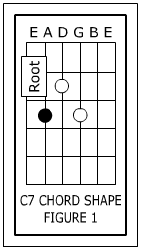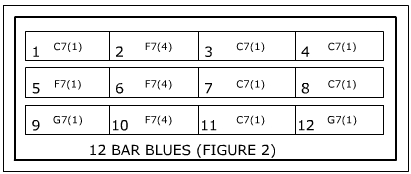
INTRODUCTION TO THE BLUES
By huskybones
hb
By huskybones
Hey everybody! The topic for today is the blues. That's right kids, I'm talkin' about the low down, tore down, gut bucket, red house, cross-cut saw, everybody's last name is King blues. This is, of course, a very deep subject, so let's just call this an introduction.
One of the basic elements of the blues is the
12 bar chord progression. For those of you new to the topic of chord
progressions, let's cover the fundamentals. A bar is when you count
to 4 and hear a snare drum on 2 and 4. So 1-Snare-3-Snare equals one
bar. Then 12 of these equals...oh well you get it. The next element
is the actual chord used. The chord in question is called the Dominant
7th chord, usually shown as a letter next to a 7 (i.e.. C7, G7). This
chord is a whole subject by itself so for now just look at Figure 1
and put the root (lowest note) of that shape on the appropriate spot
on the neck. Finding the right spot on the neck requires that you know
the names of the notes. If you need help with this, there are many good,
inexpensive books that have charts with all the notes shown.

The next step is to look at the way the chords
move through the twelve bars. If we look at Figure 2, we find a very
typical example of a twelve bar blues.

Keep in mind that this isn't the only way to play it. There are lots
of subtle variations. This example is in the key of 'C'. This chord
progression is also known as a "One, Four, Five", so for reference,
the numbers of each chord are in parentheses to the right of the chord.
You'll notice that alphabetically F(4) is four notes from C(1). Similarly
G(5) is five notes from C. See how easy it is?
One last point to cover is what's called the turnaround. The turnaround is the name for the last two measures (11 and 12) just before you start the whole chord progression over. The turnaround here is basic but it'll work every time.
Finally, for you masochists who actually want
to practice this stuff, I've written the 1-4-5 progressions for all
twelve keys plus the "enharmonic keys"(Figure 3). So go on, try this
stuff out and always remember the words of our home town pundit Dan
Quayle, "If we do not succeed, then we run the risk of failure." I find
this strangely inspiring.

hb